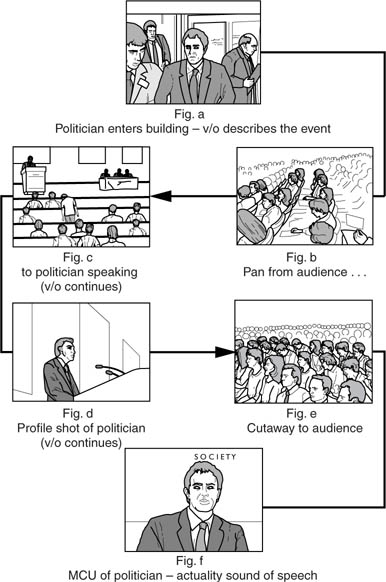Video and audio can be recorded on a number of mediums: tape, optical, hard disk, or high density memory chips (integrated circuits). Tape has been the preferred method of acquisition because of its of storage capacity and cost.
Cameras recording on tape are recording in a linear manner. When the tape is edited it has to be spooled backwards and forwards to access the required shot. This is time consuming with up to 40% of the editing session spent spooling, jogging and previewing edits. Although modern VTRs have a very quick lock-up, less than a second, allowing relatively short pre-rolls, normally all edits are previewed which involves performing everything except allowing the record machine to be switched to record. The finished edited master has limited flexibility for later readjustment and requires a return to an edit session of the originating tapes if a different order of shots is required.
News acquisition and transmission requires the fastest possible turnaround time that can be achieved and non-linear editing (apart from the initial fast-dub from tape to store) is usually quicker than linear editing. Also it has the great advantage of being able to be recut to fit different news bulletins and updates on the story. Newsrooms are being planned around workstations where journalists can review, edit and voice-over material acquired in the field. Inevitably, post production, transmission and eventually acquisition are moving towards a server or disk-based environment.
Non-linear editing requires the ability to store vast amounts of digital data. With increasing computer power this has become available at a steadily decreasing cost. IBM estimates that the price of computer storage, in terms of price per megabyte, is halving every eighteen months, doubling the storage available for the same cost. Eventually quality digital video storage costs will match existing tape techniques and the transition from analogue tape to the digital disc-based system (or similar) will be complete.
The efficient use of the high cost of video data storage requires some form of compression. Although the cost of data storage decreases each year, it is still not economic to record uncompressed video for any useful length of time. Uncompressed component digital requires 270 MB per second – 486 GB for a half-hour recording. Digital compression can be transparent depending on content and cost but there are limitations. Combining different compressions for shooting, editing and transmission can cause problems. Digitizing the signal and then at each stage in the production/transmission process repeatedly coding and decoding the signal, can have a compound effect on the picture quality that in sum, is considerably worse than the individual compressions initially suggest.

A politician enters a conference hall and delivers a speech to an audience. This whole event, possibly lasting 30 minutes or more, can be reduced to 15 seconds of screen time by cutting between the appropriate shots. In the first shot (Fig. a), the politician is seen entering the building with a voice-over giving details of the purpose of the visit. A cutaway to an audience shot with a pan to the politician on the platform (Figs c, d) allows all the intervening time to be collapsed without a jump cut, and also allows the voice-over to paraphrase what the politician is saying. A third, closer, profile shot of the politician (Fig. e), followed by a shot of the listening audience (Fig. f), continues with the voice-over paraphrase, ending with a MCU of the politician (Fig. f), with his actuality sound, delivering the key ‘sound bite’ sentence of his speech. A combination of voice-over and five shots that can be cut together maintaining continuity of time and place allows a 30 minute event to be delivered in 15/20 seconds.
Provided the main subject does not leap in vision from location one immediately to location two, and then to three and four, there will be no jump in continuity between shots. The empty frames and cutaways allow the editing-out of space and time to remain invisible. News editing frequently requires a reduction in screen time of the actual duration of a real event. For example, a 90 minute football match recording will be edited down to 30 seconds to run as a ‘highlights’ report in a news bulletin. Screen time is seldom made greater than the event time, but there are instances, for example, in reconstructions of a crime in a documentary, where time is expanded by editing. This stylistic mannerism is often accompanied by slow motion sequences.
